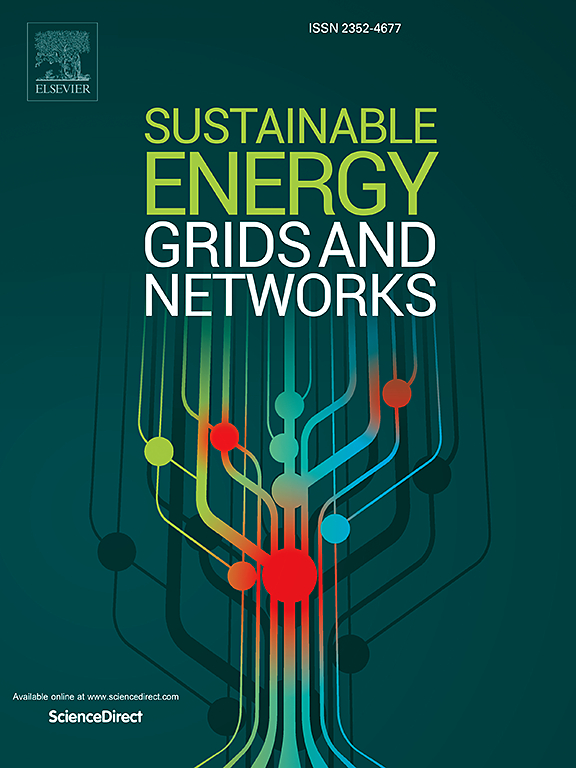微电网规模、电动汽车调度及车网一体化多目标优化
IF 5.6
2区 工程技术
Q2 ENERGY & FUELS
引用次数: 0
摘要
本文提出了一个多目标混合整数线性规划(MILP)框架,用于集成分布式能源(DER)的微电网的规模,如热发电机(TG),光伏系统(PV)系统和电池储能系统(BESS),以及电动汽车(EV)调度和电动汽车充电站(EVCS)的采购。通过基于场景的随机规划方法,提出的公式结合了发电和需求概况的不确定性,以及对离网情景建模的偶然性。通过采用线性化方法,消除了对充放电决策的额外二元变量的需求,优化同时最大限度地降低了总成本、温室气体(GHG)排放和电动汽车闲置时间。该模型还通过纳什均衡确定了最优的车辆到电网(V2G)价格,以平衡系统运营商和电动汽车所有者的利益。数值结果表明,允许适当的电动汽车怠速时间可以减少所需的EVCS数量,从而在不显著影响排放的情况下降低资本投资。此外,在严格限制温室气体排放的情况下,光伏和BESS的份额会更高,这增加了总体成本,但减少了排放。实例研究表明,优化后的微电网可以有效应对离网情况,BESS和电动汽车的贡献维持了供电可靠性。本文章由计算机程序翻译,如有差异,请以英文原文为准。
Multi-objective optimization for microgrid sizing, electric vehicle scheduling and vehicle-to-grid integration
This paper presents a multi-objective mixed integer linear programming (MILP) framework for the sizing of a microgrid that integrates distributed energy resource (DER), such as thermal generator (TG), photovoltaic system (PV) systems, and battery energy storage system (BESS), alongside electric vehicle (EV) scheduling and the procurement of electric vehicle charging station (EVCS). The proposed formulation incorporates uncertainty in generation and demand profiles, as well as contingencies that model off-grid scenarios, by means of a scenario-based stochastic programming approach. By employing a linearization approach that eliminates the need for additional binary variables for charging and discharging decisions, the optimization simultaneously minimizes total cost, greenhouse gas (GHG) emissions, and EV idle time. The model also determines an optimal vehicle-to-grid (V2G) price through a Nash equilibrium, which balances the interests of both the system operator and EV owners. Numerical results indicate that allowing moderate EV idle time can reduce the required number of EVCS, thus lowering capital investment without substantially affecting emissions. Furthermore, scenarios with stringent GHG constraints lead to a higher share of PV and BESS, increasing overall cost but reducing emissions. A case study demonstrates that the optimized microgrid can effectively handle off-grid conditions, with BESS and EV contributions maintaining supply reliability.
求助全文
通过发布文献求助,成功后即可免费获取论文全文。
去求助
来源期刊

Sustainable Energy Grids & Networks
Energy-Energy Engineering and Power Technology
CiteScore
7.90
自引率
13.00%
发文量
206
审稿时长
49 days
期刊介绍:
Sustainable Energy, Grids and Networks (SEGAN)is an international peer-reviewed publication for theoretical and applied research dealing with energy, information grids and power networks, including smart grids from super to micro grid scales. SEGAN welcomes papers describing fundamental advances in mathematical, statistical or computational methods with application to power and energy systems, as well as papers on applications, computation and modeling in the areas of electrical and energy systems with coupled information and communication technologies.
 求助内容:
求助内容: 应助结果提醒方式:
应助结果提醒方式:


